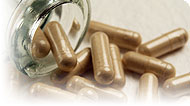health guides
Kelp

How to Use It
Since the introduction of iodized salt, additional sources of iodine, such as kelp, are not necessary for most people. However, kelp can be consumed as a source of other minerals. A report from Great Britain indicated that the average kelp-based supplement contained 1,000 mcg of iodine (the adult RDA in the United States is 150 mcg per day). It has been suggested that intakes above 2,000 mcg per day should be regarded as excessive or potentially harmful.1
Where to Find It
Kelp can be one of a few brown-coloured seaweed species called Laminaria.
Possible Deficiencies
People who avoid sea vegetables, as well as dairy, seafood, processed food, and the salt shaker, can become deficient in iodine. Iodine deficiency can cause low thyroid function, goitre, and cretinism. Although iodine deficiency is now uncommon in Western societies, the U.S. population has shown a trend of significantly decreasing iodine intake.
Copyright © 2024 TraceGains, Inc. All rights reserved.
Learn more about TraceGains, the company.
The information presented by TraceGains is for informational purposes only. It is based on scientific studies (human, animal, or in vitro), clinical experience, or traditional usage as cited in each article. The results reported may not necessarily occur in all individuals. Self-treatment is not recommended for life-threatening conditions that require medical treatment under a doctor's care. For many of the conditions discussed, treatment with prescription or over the counter medication is also available. Consult your doctor, practitioner, and/or pharmacist for any health problem and before using any supplements or before making any changes in prescribed medications. Information expires December 2024.


 We are proud to announce that
We are proud to announce that  As the market evolves, customers increasingly request a wider variety of omega-3 options for their lipid...
As the market evolves, customers increasingly request a wider variety of omega-3 options for their lipid...  Maintaining healthy glucose levels is crucial for preventing metabolic conditions like diabetes,...
Maintaining healthy glucose levels is crucial for preventing metabolic conditions like diabetes,...  Looking at formulating a new vitamin blend? Discover
Looking at formulating a new vitamin blend? Discover 







































